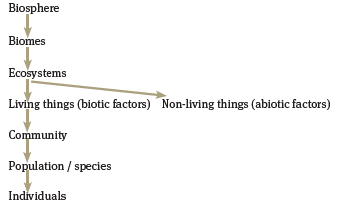ElimuZA Access to Education
Agro-Ecology Questions and Answers Grade 10
Share via Whatsapp Join our WhatsApp Group Join our Telegram GroupTopic 1: Questions and Answers
- Answer the questions below.
- Give yourself one hour.
- Check your answers afterwards and do corrections.
Questions
- Define ecology? (2)
- Describe what an agro-ecosystem is. (3)
- Draw a diagram to show the levels of organisations in an ecosystem. (8)
- Discuss the physiographic factors in an ecosystem. Explain the influence that each physiographic factor has on an ecosystem. (12)
- Draw and label a simple a food chain. (5)
- Describe the five types of interaction that are found in ecosystems. Provide an example of each type of interaction. (15)
- List the main features of biological farming. (5)
- What is selective grazing? (3)
- What is stocking rate? (4)
- List the three main veld types in South Africa. (3)
- Name the ten categories that are scored to determine the condition of pasture. (10)
- Identify the six main types of biomes in South Africa. (6)
- List the four main causes of global warming. (4)
[Total marks: 70]
Answers
- Ecology is the study of all the relationships between living organisms and the environment in which they lives
- An agro-ecosystem is an ecosystem that consists of agricultural plants and animals.

- Slope: This refers to the steepness of the land. The steeper the slope, the more runoff occurs: not much plant life can be supported.
Aspect: The direction in which the slope faces. In the southern hemisphere, north- facing slopes are hotter and drier as they receive more sunlight. This influences plant life.
Altitude: The height of the land above sea level. Temperature decreases with increasing altitude. This affects plant and animal life. 
-
- Competition: Organisms compete for limited resources (food, water, territory):
- Intraspecific competition: animals of the same species (e.g. two male lions) competing to mate with the same lioness.
- Interspecific competition: animals of different species (e.g. cheetahs and lions) competing for same prey.
- Predator and prey: A predator (the animal that hunts) eats its prey (the animal that is hunted) e.g. a lion and an antelope.
- Mutualism: Both organisms benefit from the relationship, e.g. ungulates and bacte- ria in intestines of cattle: bacteria produce cellulase (enzyme) that digests cellulose.
- Commensalism: One organism benefits, the other doesn’t, but is not harmed either, e.g. shark and remora.
- Parasitism: One organism (parasite) lives on or within and feeds on another (the host). The parasite benefits, but the host is weakened, e.g. cholera virus.
- Competition: Organisms compete for limited resources (food, water, territory):
-
- Ensuring soil has correct nutrient balance: the soil is tested for ten nutrients to determine the amount of nitrogen to be added.
- Ensuring that soil contains sufficient microbes for correct pH level (acidity and alkalinity).
- Using natural fertilisers, such as compost, as far as possible.
- No herbicides and pesticides.
- Rotating crops every year or two.
- Animals eat the most palatable plants and leave the unpalatable ones. The result is that only the unpalatable plants remain and the veld becomes of little use for grazing farm animals.
- Stocking rate (SR) is the number of animals that can graze on one hectare of land, for the grazeable part of one year, which excludes winter, without doing damage to the condition of the veld.
- Sweetveld; sourveld; mixed veld.
- Plant desirability; plant diversity; plant density; plant vigour; legumes; severity of use; uniformity of use; soil erosion; woody canopy; plant residue.
- Savanna; forest; grassland; fynbos; succulent Karoo; Nama Karoo.
- Fires; industry; vehicles; power stations.
[Total marks: 70]

